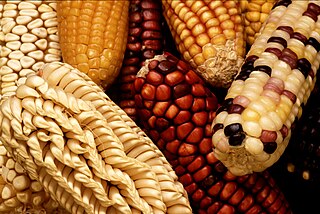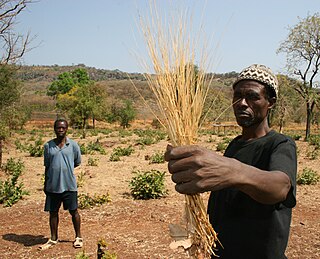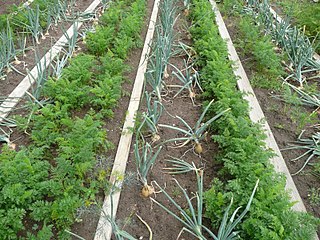
A seed bank stores seeds to preserve genetic diversity; hence it is a type of gene bank. There are many reasons to store seeds. One is to preserve the genes that plant breeders need to increase yield, disease resistance, drought tolerance, nutritional quality, taste, etc. of crops. Another is to forestall loss of genetic diversity in rare or imperiled plant species in an effort to conserve biodiversity ex situ. Many plants that were used centuries ago by humans are used less frequently now; seed banks offer a way to preserve that historical and cultural value. Collections of seeds stored at constant low temperature and low moisture are guarded against loss of genetic resources that are otherwise maintained in situ or in field collections. These alternative "living" collections can be damaged by natural disasters, outbreaks of disease, or war. Seed banks are considered seed libraries, containing valuable information about evolved strategies to combat plant stress, and can be used to create genetically modified versions of existing seeds. The work of seed banks spans decades and even centuries. Most seed banks are publicly funded and seeds are usually available for research that benefits the public.

Domestication is a sustained multi-generational relationship in which one group of organisms assumes a significant degree of influence over the reproduction and care of another group to secure a more predictable supply of resources from that second group. The domestication of plants and animals was a major cultural innovation ranked in importance with the conquest of fire, the manufacturing of tools, and the development of verbal language.

Cicer is a genus of the legume family, Fabaceae, and the only genus found in tribe Cicereae. It is included within the IRLC, and its native distribution is across the Middle East and Asia. Its best-known and only domesticated member is Cicer arietinum, the chickpea.

A landrace is a domesticated, locally adapted, traditional variety of a species of animal or plant that has developed over time, through adaptation to its natural and cultural environment of agriculture and pastoralism, and due to isolation from other populations of the species. Landraces are generally distinguished from cultivars, and from breeds in the standardized sense, although the term landrace breed is sometimes used as distinguished from the term standardized breed when referring to cattle.

Agricultural biodiversity is a sub-set of general biodiversity. Otherwise known as agrobiodiversity, agricultural biodiversity is a broad term that includes "the variety and variability of animals, plants and micro-organisms at the genetic, species and ecosystem levels that sustain the ecosystem structures, functions and processes in and around production systems, and that provide food and non-food agricultural products.” managed by farmers, pastoralists, fishers and forest dwellers, agrobiodiversity provides stability, adaptability and resilience and constitutes a key element of the livelihood strategies of rural communities throughout the world. Agrobiodiversity is central to sustainable food systems and sustainable diets. The use of agricultural biodiversity can contribute to food security, nutrition security, and livelihood security, and it is critical for climate adaptation and climate mitigation.

Digitaria exilis, referred to as findi or fundi in areas of Africa, such as The Gambia, with English common names white fonio, fonio millet, and hungry rice or acha rice, is a grass species. It is the most important of a diverse group of wild and domesticated Digitaria species known as fonio that are harvested in the savannas of West Africa. The grains are very small. It has potential to improve nutrition, boost food security, foster rural development and support sustainable use of the land. Despite its valuable characteristics and widespread cultivation, fonio has generally received limited attention research and development, which is also why the species is sometimes referred to as an underutilized crop.
Food biodiversity is defined as "the diversity of plants, animals and other organisms used for food, covering the genetic resources within species, between species and provided by ecosystems."

Chenopodium berlandieri, also known by the common names pitseed goosefoot, huauzontle, lamb's quarters, and lambsquarters is an annual herbaceous plant in the family Amaranthaceae.
Genetic pollution is a controversial term for uncontrolled gene flow into wild populations. It is defined as "the dispersal of contaminated altered genes from genetically engineered organisms to natural organisms, esp. by cross-pollination", but has come to be used in some broader ways. It is related to the population genetics concept of gene flow, and genetic rescue, which is genetic material intentionally introduced to increase the fitness of a population. It is called genetic pollution when it negatively impacts on the fitness of a population, such as through outbreeding depression and the introduction of unwanted phenotypes which can lead to extinction.
Genetic erosion is a process where the limited gene pool of an endangered species diminishes even more when reproductive individuals die off before reproducing with others in their endangered low population. The term is sometimes used in a narrow sense, such as when describing the loss of particular alleles or genes, as well as being used more broadly, as when referring to the loss of a phenotype or whole species.

A crop wild relative (CWR) is a wild plant closely related to a domesticated plant. It may be a wild ancestor of the domesticated (cultivated) plant, or another closely related taxon.
Jack Rodney Harlan was a botanist, agronomist, plant collector, and campaigner for crop plant biodiversity conservation.

Crop diversity is the variance in genetic and phenotypic characteristics of plants used in agriculture. Over the past 50 years, there has been a major decline in two components of crop diversity; genetic diversity within each crop and the number of species commonly grown.

Boguslav Stanislavovich Kurlovich is a Russian-Finnish scientific agronomist of Polish descent. He specializes in the field of plant genetic resources, botany, plant and fish breeding.
Plant breeding started with sedentary agriculture, particularly the domestication of the first agricultural plants, a practice which is estimated to date back 9,000 to 11,000 years. Initially, early human farmers selected food plants with particular desirable characteristics and used these as a seed source for subsequent generations, resulting in an accumulation of characteristics over time. In time however, experiments began with deliberate hybridization, the science and understanding of which was greatly enhanced by the work of Gregor Mendel. Mendel's work ultimately led to the new science of genetics. Modern plant breeding is applied genetics, but its scientific basis is broader, covering molecular biology, cytology, systematics, physiology, pathology, entomology, chemistry, and statistics (biometrics). It has also developed its own technology. Plant breeding efforts are divided into a number of different historical landmarks.
Cucurbita fraterna, also known as Cucurbita pepo subsp. fraterna, is a mesophyte plant species of the genus Cucurbita. It is native to Tamaulipas and Nuevo León, Mexico. It has not been domesticated. It is the progenitor and nearest relative of the domesticated species Cucurbita pepo and wild C. pepo is still found in the same areas as C. fraterna. It was formally described by Liberty Hyde Bailey in 1943, in Gentes Herbarum.
Erna Bennett (1925–2012) was a plant geneticist and one of the early pioneers of genetic conservation. She was one of the first to raise the issue of biodiversity loss at the United Nations.
Plant genetic resources are plant genetic materials of actual or potential value. They describe the variability within plants that comes from human and natural selection over millennia. Their intrinsic value mainly concerns agricultural crops.
Elena Ivanovna Barulina was a Russian botanist and geneticist who did pioneering research on lentils and their wild relatives. In 1930, she published the first map of their international distribution, in a 317-page monograph that became the standard reference for researchers. The standard author abbreviation Barulina is used to indicate this person as the author when citing a botanical name.
Genetic resources means genetic material of actual or potential value where genetic material means any material of plant, animal, microbial or other origin containing functional units of heredity... Genetic resources thus refer to the part of genetic diversity that has or could have practical use, such as in plant breeding. The term was introduced by Otto Frankel and Erna Bennett for a technical conference on the exploration, utilization and conservation of plant genetic resources, organized by the Food and Agriculture Organisation (FAO) and the International Biological Program (IBP), held in Rome, Italy, 18–26 September 1967.











